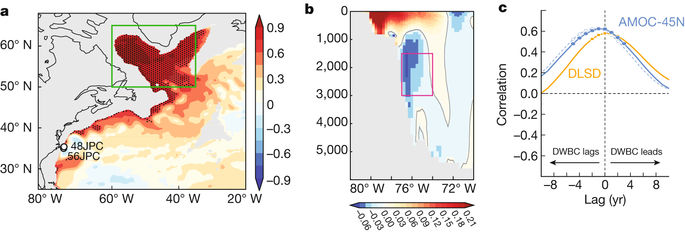Our official English website, www.x-mol.net, welcomes your feedback! (Note: you will need to create a separate account there.)
Anomalously weak Labrador Sea convection and Atlantic overturning during the past 150 years
Nature ( IF 64.8 ) Pub Date : 2018-04-01 , DOI: 10.1038/s41586-018-0007-4 David J. R. Thornalley , Delia W. Oppo , Pablo Ortega , Jon I. Robson , Chris M. Brierley , Renee Davis , Ian R. Hall , Paola Moffa-Sanchez , Neil L. Rose , Peter T. Spooner , Igor Yashayaev , Lloyd D. Keigwin
Nature ( IF 64.8 ) Pub Date : 2018-04-01 , DOI: 10.1038/s41586-018-0007-4 David J. R. Thornalley , Delia W. Oppo , Pablo Ortega , Jon I. Robson , Chris M. Brierley , Renee Davis , Ian R. Hall , Paola Moffa-Sanchez , Neil L. Rose , Peter T. Spooner , Igor Yashayaev , Lloyd D. Keigwin

|
The Atlantic meridional overturning circulation (AMOC) is a system of ocean currents that has an essential role in Earth’s climate, redistributing heat and influencing the carbon cycle1, 2. The AMOC has been shown to be weakening in recent years1; this decline may reflect decadal-scale variability in convection in the Labrador Sea, but short observational datasets preclude a longer-term perspective on the modern state and variability of Labrador Sea convection and the AMOC1, 3–5. Here we provide several lines of palaeo-oceanographic evidence that Labrador Sea deep convection and the AMOC have been anomalously weak over the past 150 years or so (since the end of the Little Ice Age, LIA, approximately ad 1850) compared with the preceding 1,500 years. Our palaeoclimate reconstructions indicate that the transition occurred either as a predominantly abrupt shift towards the end of the LIA, or as a more gradual, continued decline over the past 150 years; this ambiguity probably arises from non-AMOC influences on the various proxies or from the different sensitivities of these proxies to individual components of the AMOC. We suggest that enhanced freshwater fluxes from the Arctic and Nordic seas towards the end of the LIA—sourced from melting glaciers and thickened sea ice that developed earlier in the LIA—weakened Labrador Sea convection and the AMOC. The lack of a subsequent recovery may have resulted from hysteresis or from twentieth-century melting of the Greenland Ice Sheet6. Our results suggest that recent decadal variability in Labrador Sea convection and the AMOC has occurred during an atypical, weak background state. Future work should aim to constrain the roles of internal climate variability and early anthropogenic forcing in the AMOC weakening described here.Palaeoclimate records show that the Atlantic meridional overturning circulation weakened substantially at the end of the Little Ice Age, probably in response to enhanced freshwater fluxes from the Arctic and Nordic seas.
中文翻译:

过去 150 年来拉布拉多海对流异常微弱和大西洋翻转
大西洋经向翻转环流 (AMOC) 是一种洋流系统,对地球气候、热量重新分配和碳循环具有重要作用1、2。近年来,AMOC 已被证明正在减弱 1;这种下降可能反映了拉布拉多海对流的年代际变化,但短期的观测数据集排除了对拉布拉多海对流和 AMOC1, 3-5 的现代状态和变化的长期观点。在这里,我们提供了几条古海洋学证据,表明与之前的 1500 年相比,拉布拉多海深对流和 AMOC 在过去 150 年左右(自小冰河时代结束后,大约在公元 1850 年)异常微弱年。我们的古气候重建表明,这种转变要么是在 LIA 结束时发生的突然转变,要么是在过去 150 年中以更渐进的持续下降的形式发生;这种模糊性可能源于非 AMOC 对各种代理的影响,或源于这些代理对 AMOC 各个组成部分的不同敏感性。我们认为,在 LIA 末期,来自北极和北欧海域的淡水通量增加(源自 LIA 早期形成的冰川融化和海冰增厚)削弱了拉布拉多海对流和 AMOC。缺乏随后的恢复可能是由于滞后现象或格陵兰冰盖 20 世纪的融化造成的。我们的结果表明,最近拉布拉多海对流和 AMOC 的年代际变化是在非典型的弱背景状态下发生的。未来的工作应旨在限制内部气候变率和早期人为强迫在此处描述的 AMOC 减弱中的作用。 古气候记录显示大西洋经向翻转环流在小冰河时代末期大幅减弱,可能是对淡水通量增加的反应来自北极和北欧海域。
更新日期:2018-04-01
中文翻译:

过去 150 年来拉布拉多海对流异常微弱和大西洋翻转
大西洋经向翻转环流 (AMOC) 是一种洋流系统,对地球气候、热量重新分配和碳循环具有重要作用1、2。近年来,AMOC 已被证明正在减弱 1;这种下降可能反映了拉布拉多海对流的年代际变化,但短期的观测数据集排除了对拉布拉多海对流和 AMOC1, 3-5 的现代状态和变化的长期观点。在这里,我们提供了几条古海洋学证据,表明与之前的 1500 年相比,拉布拉多海深对流和 AMOC 在过去 150 年左右(自小冰河时代结束后,大约在公元 1850 年)异常微弱年。我们的古气候重建表明,这种转变要么是在 LIA 结束时发生的突然转变,要么是在过去 150 年中以更渐进的持续下降的形式发生;这种模糊性可能源于非 AMOC 对各种代理的影响,或源于这些代理对 AMOC 各个组成部分的不同敏感性。我们认为,在 LIA 末期,来自北极和北欧海域的淡水通量增加(源自 LIA 早期形成的冰川融化和海冰增厚)削弱了拉布拉多海对流和 AMOC。缺乏随后的恢复可能是由于滞后现象或格陵兰冰盖 20 世纪的融化造成的。我们的结果表明,最近拉布拉多海对流和 AMOC 的年代际变化是在非典型的弱背景状态下发生的。未来的工作应旨在限制内部气候变率和早期人为强迫在此处描述的 AMOC 减弱中的作用。 古气候记录显示大西洋经向翻转环流在小冰河时代末期大幅减弱,可能是对淡水通量增加的反应来自北极和北欧海域。



























 京公网安备 11010802027423号
京公网安备 11010802027423号